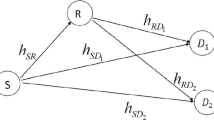Abstract
Non-orthogonal multiple access (NOMA) is a superior technique for achieving massive-scale connectivity and high spectral efficiency requirements for beyond-5G (B5G) networks. This paper focuses on a performance analysis of the achievable capacity and bit error rate (BER) at far and near users of downlink NOMA in a multiple-input multiple-output (MIMO) system under imperfect successive interference cancellation (SIC) for different modulation schemes. Paired binary phase-shift keying–binary phase-shift keying (BPSK-PAIR) and quadrature phase-shift keying–quadrature phase-shift keying (QPSK-PAIR) are the modulation methods that are employed. Analytical expressions are developed and simulated using Gaussian Q-functions. The simulated findings show that the suggested MIMO system outperforms a NOMA system without MIMO at the expense of greater computational complexity than either a MIMO OMA system or the NOMA system without MIMO. The sum capacity obtained for the proposed system at a signal-to-noise ratio (SNR) of 25 dB is 11.93 bps/Hz, and the BERs at far and near users are 3.7 × 10−4 and 8.5 × 10−4, respectively.








Similar content being viewed by others
References
Khan A, Shin SY (2017) Linear precoding techniques for OFDM-based NOMA over frequency-selective fading channels. IETE J Res 63(4):536–551
Islam SMR, Avazov N, Dobre OA, and Kwak K (2017) Power - domain Non - Orthogonal Multiple Access (NOMA) in 5G systems: potentials and challenges. IEEE Commun Surv Tutorials 1–41
Ding Z, Liu Y, Choi J, Sun Q, Elkashlan M, Chih-Lin I, Poor HV (2017) Application of Non-Orthogonal Multiple Access in LTE and 5G networks. IEEE Commun Mag 55:185–191
Liu Y, Qin Z, Elkashlan M, Ding Z, Nallanathan A, Hanzo L (2017) Nonorthogonal Multiple Access for 5G and beyond. Proc IEEE 105:2347–2381
Aldababsa M, Toka M, Gökçeli S, Kurt GK, Kucur O (2018) A tutorial on nonorthogonal multiple access for 5G and beyond. Wirel Commun Mob Comput 2018(Article ID 9713450), 24 p. https://doi.org/10.1155/2018/9713450
Chen Z, Ding Z, Dai X, Zhang R (2017) An optimization perspective of the superiority of NOMA compared to conventional OMA. IEEE Trans Signal Process 65(19):5191–5202. https://doi.org/10.1109/TSP.2017.2725223
Ding Z, Yang Z, Fan P, Poor HV (2014) On the performance of non-orthogonal multiple access in 5G systems with randomly deployed users. IEEE Signal Process Lett 21:1501–1505
Manimekalai T (2020) Sparjan Romera Joan, and Thangavelu Laxmikandan, Throughput maximization for underlay CR multicarrier NOMA network with cooperative communication. ETRI J WILEY 42:846–858
Goutham V, Harigovindan VP (2021) Full-duplex cooperative relaying with NOMA for the performance enhancement of underwater acoustic sensor networks. Eng Sci Technol an Int J 24:1396–1407
Li Q, Wen M, Basar E, Poor HV, Chen F (2019) Spatial modulation-aided cooperative NOMA: performance analysis and comparative study. IEEE J Sel Top Signal Process 13:715–728
Srikamu C, Jayabharathy R (2022) Comparative analysis of ergodic sum capacity of cooperative NOMA aided with spatial modulation. Wirel Pers Commun 123:3771–3786
Fang Z, Hu J, Lu Y, Ni W (2020) Three-user cooperative NOMA transmission. IEEE Wirel Commun Lett 9:465–469
Sun Q, Han S, Chin-Lin I, Pan Z (2015) On the ergodic capacity of MIMO NOMA systems. IEEE Wirel Commun Lett 4:405–408
Yu S, Khan WU, Zhang X, Liu J (2021) Optimal power allocation for NOMA-enabled D2D communication with imperfect SIC decoding. Physical Communication 46:101296. https://doi.org/10.1016/j.phycom.2021.101296
Baidas MW, Alsusa E, Hamdi KA (2019) Joint subcarrier assignment and weighted-sum energy-efficient power allocation in multi-carrier uplink NOMA relay networks. Physical Communication 36:100821. https://doi.org/10.1016/j.phycom.2019.100821
Dai J, Niu K, Si Z, Dong C, Lin J (2018) Polar-coded non-orthogonal multiple access. IEEE Trans Signal Process 66:1374–1389
Aghdam MRG, Tazehkand BM, Abdolee R (2020) On the performance analysis of mmWave MIMO-NOMA transmission scheme. IEEE Trans Veh Technol 69:11491–11500
Aghdam MRG, Tazehkand BM, Abdolee R (2022) Joint optimal power allocation and beamforming for MIMO-NOMA in mmWave communications. IEEE Wirel Commun Lett 11:938–941
Lv T, Ma Y, Zeng J, Mathiopoulos PT (2018) Millimeter-wave NOMA transmission in cellular M2M communications for Internet of Things. IEEE Internet Things J 5:1989–2000
Jain M, Soni S, Sharma N, Rawal D (2019) Performance analysis at far and near user in NOMA based system in presence of SIC error. AEU - Int J Electron Commun 114:152993. https://doi.org/10.1016/j.aeue.2019.152993
Tasneem A, Ai-Dweik AJ, Moursi MSE, Zeineldin H, Ai-Jarrah M (2020) Exact bit error-rate analysis of two-user NOMA using QAM with arbitrary modulation orders. IEEE Commun Lett 24:2705–2709
Sashiganth M, Thiruvengadam SJ, Kumar DS (2020) BER analysis of full duplex NOMA downlink and uplink co-operative user relaying systems over Nakagami-m fading environment. Phys Commun 38:100963
Goldsmith AJ (2005) Wireless communications. Cambridge University Press, London
Simon MK, Alouini M-S (2005) Digital communication over fading channels. Wiley-IEEE Press Second Edition
Acknowledgements
The authors wish to thank the management of SASTRA Deemed University and Keysight Technologies for establishing the SASTRA-Keysight Centre of Excellence in RF System Engineering, which provided the software facilities used to carry out this research work.
Author information
Authors and Affiliations
Corresponding author
Ethics declarations
Conflict of interest
The authors declare no competing interests.
Additional information
Publisher's note
Springer Nature remains neutral with regard to jurisdictional claims in published maps and institutional affiliations.
Rights and permissions
Springer Nature or its licensor (e.g. a society or other partner) holds exclusive rights to this article under a publishing agreement with the author(s) or other rightsholder(s); author self-archiving of the accepted manuscript version of this article is solely governed by the terms of such publishing agreement and applicable law.
About this article
Cite this article
Srikamu, C., Narayan, K.G.S., Karthikeyan, S. et al. Performance analysis of NOMA in a MIMO system over Rayleigh channels under imperfect SIC. Ann. Telecommun. 78, 101–113 (2023). https://doi.org/10.1007/s12243-022-00933-8
Received:
Accepted:
Published:
Issue Date:
DOI: https://doi.org/10.1007/s12243-022-00933-8




